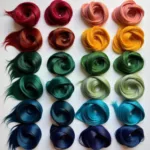Choosing the right lighting for your bedroom can significantly impact your sleep quality. While you may have heard that darkness is best for sleep, did you know that certain LED colors can actually promote relaxation and improve your sleep cycle? This article explores the fascinating relationship between LED light color and sleep, helping you discover the best hue to transform your bedroom into a sleep sanctuary.
How Does LED Light Color Affect Sleep?
Our bodies have a natural sleep-wake cycle called the circadian rhythm, which is regulated by the hormone melatonin. When exposed to light, our brains suppress melatonin production, signaling it’s time to be awake. Conversely, darkness encourages melatonin release, preparing our bodies for sleep.
LED lights emit different color temperatures, measured in Kelvin (K), which can influence melatonin production and, consequently, our sleep:
- Warm Light (2700-3000K): Mimicking the warm glow of sunset, this light color has the least impact on melatonin production, making it ideal for nighttime use.
- Cool White Light (4000-5000K): This bright, stimulating light can interfere with melatonin production and is better suited for daytime activities.
- Blue Light (above 6500K): Emitted by electronic devices like smartphones and laptops, blue light is the most disruptive to sleep, suppressing melatonin and increasing alertness.
What is the Best LED Light Color to Sleep With?
The best LED color for sleep is a warm, reddish light with a color temperature around 2700K. This color temperature closely resembles the hues of sunset and candlelight, signaling to your brain that it’s time to wind down.
“Warm, reddish light promotes relaxation and prepares the body for a restful night’s sleep,” explains Dr. Sarah Thompson, sleep specialist. “It’s like a gentle lullaby for your brain, easing you into a peaceful slumber.”
Other LED Light Colors and Their Effects on Sleep
While warm light is optimal for sleep, other LED colors can also be incorporated into your bedroom lighting scheme to create a relaxing ambiance:
- Amber Light: Similar to warm light, amber light has a calming effect and can help reduce anxiety.
- Red Light: Some studies suggest that red light may promote melatonin production and improve sleep quality.
- Green Light: Known for its calming properties, green light can create a sense of tranquility in the bedroom.
Tips for Choosing the Right LED Light for Sleep
Here are some tips to help you choose the best LED lights for your sleep environment:
- Opt for Warm White or Amber Bulbs: When selecting LED bulbs for your bedroom, choose those with a color temperature between 2700K and 3000K, labeled as “warm white” or “soft white”.
- Consider Smart Bulbs: Smart bulbs offer adjustable color temperatures, allowing you to customize the lighting in your bedroom throughout the day and night.
- Use Dimmers: Installing dimmer switches allows you to control the brightness of your lights, creating a relaxing atmosphere in the evening.
- Limit Blue Light Exposure: Avoid using electronic devices at least an hour before bed, as the blue light emitted from these screens can interfere with melatonin production.
Conclusion
The color of light in your bedroom can profoundly affect your sleep. By choosing warm, relaxing LED lights and minimizing exposure to blue light, you can create an optimal sleep environment and wake up feeling refreshed and energized. Remember, a well-lit bedroom is about more than just aesthetics; it’s about creating a space that promotes rest and rejuvenation.
FAQs
Q: Can I use any warm-colored light bulb for sleep?
A: While any warm-colored light bulb is better than a cool-colored one for sleep, it’s best to choose LED bulbs specifically designed for nighttime use. These bulbs emit a lower intensity of light and are less likely to disrupt your sleep.
Q: What about salt lamps?
A: Salt lamps emit a warm, amber glow that can create a relaxing ambiance in the bedroom. However, there is limited scientific evidence to support claims that they improve sleep quality.
Q: Can colored light therapy improve my sleep?
A: Some studies suggest that specific wavelengths of light, such as red light, may have a positive impact on sleep. However, more research is needed in this area. If you’re considering colored light therapy, consult with a healthcare professional.
Q: How can I minimize blue light exposure before bed?
A: You can minimize blue light exposure by:
- Avoiding screen time at least an hour before bed.
- Using blue light blocking glasses or installing blue light filters on your electronic devices.
- Reading a physical book instead of using an e-reader.
Q: Can I sleep with a small, dim light on?
A: While it’s generally recommended to sleep in complete darkness, a small, dim light may be acceptable for some individuals. If you prefer to sleep with a light on, choose a warm-colored light bulb with a very low wattage and place it away from your bed.
Looking for more ways to improve your sleep environment? Check out our articles on what’s the best led light color to sleep with and what led color is best for sleep.
Need help creating the perfect lighting scheme for your bedroom? Contact us at Phone Number: 0373298888, Email: [email protected] or visit our showroom at 86 Cầu Giấy, Hà Nội. Our team of color experts is available 24/7 to assist you.
